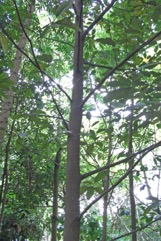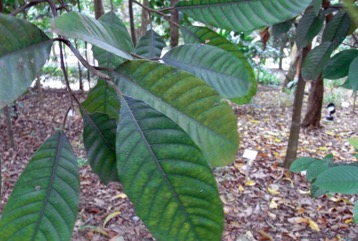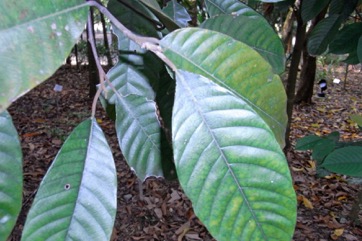Pudau, Pudu

A tropical plant. It grows in lowland forests. In Indonesia it grows up to 450 m altitude. It is often in swampy places.
Also known as:
Bodut, Bontorong, Chempedak ayer, Chempedak hutan, Fudu, Kasai, Kian, Kudu, Mangha air, Nangka air, Pudu, Puduk, Purau, Tampang bukit, Tampang gunung, Tegebut, Temedak ayer
Synonyms
- Artocarpus brunneifolia S. Moore
- Artocarpus maingayi Hook.f.
- ? King
- Artocarpus sumatranus F. M. Jarrett
Edible Portion
- Fruit, Latex
Where does Pudau grow?
Found in: Asia, Australia, Brunei, Indochina, Indonesia, Malaysia, Sarawak, SE Asia, Singapore, Thailand
Notes: There are about 50 Artocarpus species. They are in the tropics and subtropics of Asia and the Pacific.
Growing Pudau, Pudu
Cultivation: Plants can be grown from seed.
Edible Uses: Small amounts of the latex are used in cooking like coconut milk. The fruit are eaten.
Nutrition Info
per 100g edible portion| Edible Part | Energy (kcal) | Protein (g) | Iron (mg) | Vitamin A (ug) | Vitamin c (mg) | Zinc (mg) | % Water |
|---|---|---|---|---|---|---|---|
| Fruit | - | - | - | - | - | - | |
| Latex | - | - | - | - | - | - |
Pudau, Pudu Photos



References
Argent, G et al, nd, Manual of the Larger and More important non Dipterocarp Trees of Central Kalimantan Indonesia. Volume 2 Forest Research Institute, Samarinda, Indonesia. p 434
Bircher, A. G. & Bircher, W. H., 2000, Encyclopedia of Fruit Trees and Edible Flowering Plants in Egypt and the Subtropics. AUC Press. p 43
Burkill, I.H., 1966, A Dictionary of the Economic Products of the Malay Peninsula. Ministry of Agriculture and Cooperatives, Kuala Lumpur, Malaysia. Vol 1 (A-H) p 258
Chai, P. P. K. (Ed), et al, 2000, A checklist of Flora, Fauna, Food and Medicinal Plants. Lanjak Entimau Wildlife Sanctuary, Sarawak. Forestry Malaysia & ITTO. p 168
Hoare, A., 2003, Food use of the Lundayeh SW Sabah. Borneo Research Council.
Milow, P., et al, 2013, Malaysian species of plants with edible fruits or seeds and their evaluation. International Journal of Fruit Science. 14:1, 1-27
PROSEA (Plant Resources of South East Asia) handbook, Volume 2, 1991, Edible fruits and nut. p 80
Slik, F., www.asianplant.net
Soepadmo, E. and Saw, L. G., 2000, Tree Flora of Sabah and Sarawak. Forestry Malaysia. Volume Three. p 200
Sukarya, D. G., (Ed.) 2013, 3,500 Plant Species of the Botanic Gardens of Indonesia. LIPI p 138
Tankard, G., 1990, Tropical fruit. An Australian Guide to Growing and using exotic fruit. Viking p 122
World Checklist of Useful Plant Species 2020. Royal Botanic Gardens, Kew